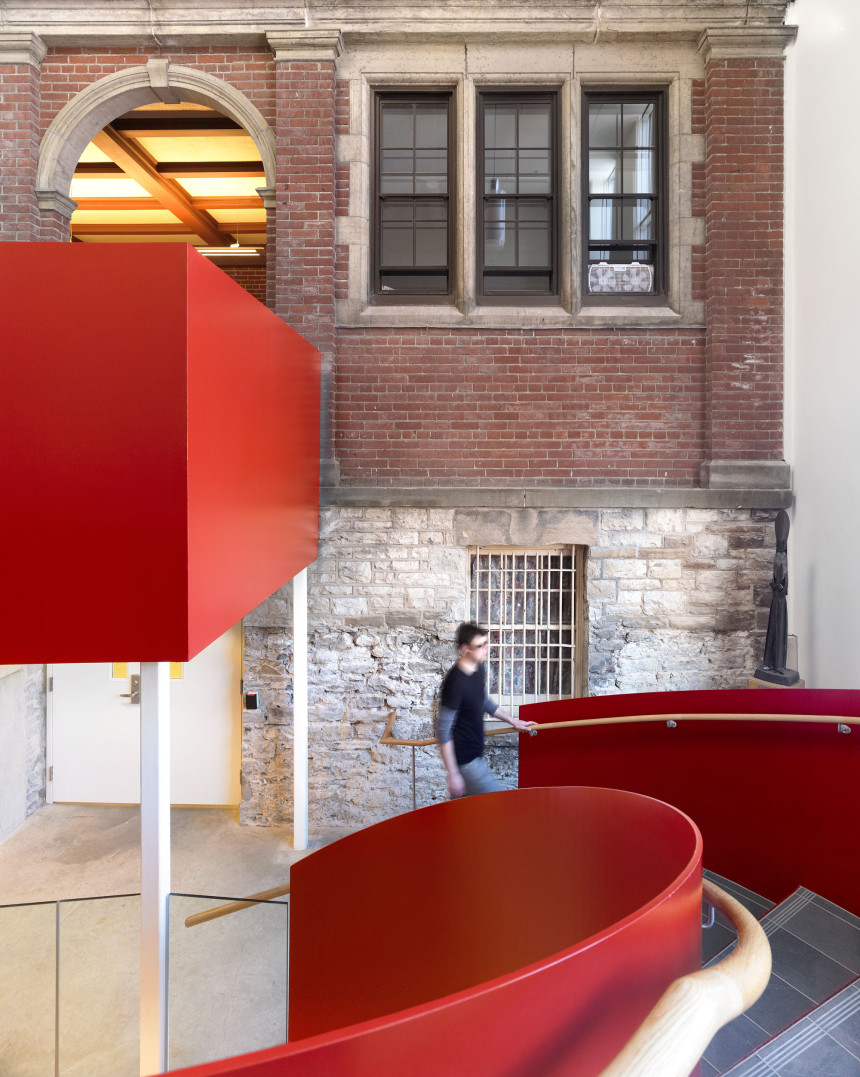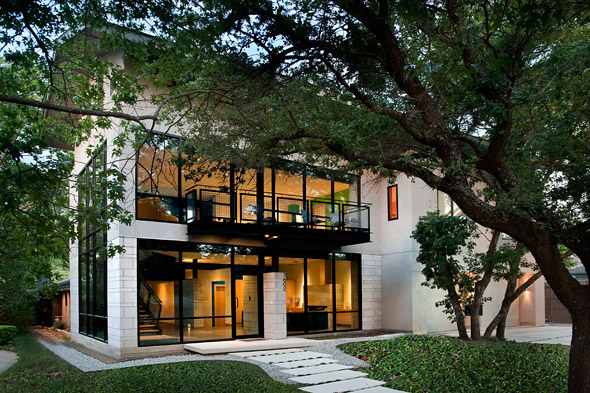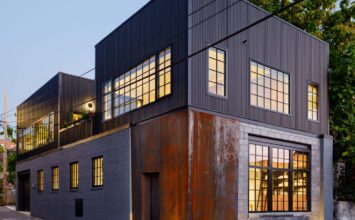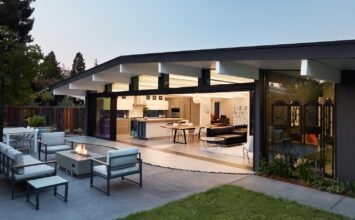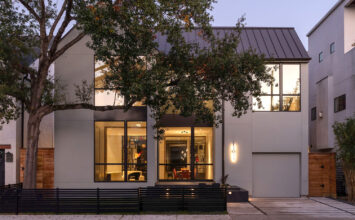
- Regis College, University of Toronto | Photo Credit: Shai Gil | Architect: Larkin Architect, Kevin Weiss Design Principal
This weekend, Modern Home Tours returns to Toronto – or “Toronto the Good,” as one of the city’s nicknames holds. An acknowledgement of Toronto’s historical embodiment of 19th century Victorian morality and mentality, this sobriquet presents a challenge to contemporary designers – how does one design in a modern idiom in a city that is genetically Victorian?
Architect and urban designer Kevin Weiss welcomes such a challenge. We sat down with Kevin – whose Russett Avenue home will be featured on this weekend’s tour – and he shared with us his insights on the modern evolution of Toronto.
Q&A w/ Kevin Weiss
You’re an architect and urban designer. What does “urban design”mean to you? Why is it important – in Toronto, and elsewhere?
I don’t so much differentiate between architecture and urban design for the reason I have always considered architecture integral to the city – buildings are part of the city and the city is composed of buildings. This is true just as much in Toronto as it is in Fez, Morocco. I have always tried to understand my projects in their urban context: how they contribute to the city and how the city affects them.
The Russett Avenue house is a good example of this integration. While it is indeed a single house, its design and form is in a large part a result of its urban context, that being one of Toronto’s Victorian-era downtown neighbourhoods.
These neighbourhoods, and much of downtown Toronto, were historically laid out with long, thin property divisions. As a result, a house type has evolved in this city that conforms to our particular urban lot configuration. Correspondingly long and narrow in its plan – built out to the side lot lines – the houses typically are limited to glazing only on the front and back elevations since the neighbouring homes are equally close to the lot line.
As a result, light and fresh air cannot penetrate into the depths of the house. In my opinion, as both an architect and someone who lives in one of these turn of the century typical downtown houses, they are too dark and too narrow; antithetical indeed to the most important characteristics that define the a modern house – light and space. Of course you can fit a house up with a modern façade, take a few walls down and paint them white, but in the end, the historical urban block structure is like a genetic encoding that affects the architecture. The form of the house remains essentially Victorian.
The design of the Russett Avenue house was thus very much an examination of this Victorian house type. Rather than trying to imagine some new house form that could be fitted to the narrow lot, the design of the house became about how to genetically modify the type in order to improve it; to bring into it the light, air, and space that it lacks. In other words, how to design a modern house despite the Victorian genes.

- Russett Avenue Residence | Photo: Weiss Architecture & Urbanism Limited | Architect: Kevin Weiss Principal , Weiss Architecture & Urbanism Limited, Larkin Architect
You’ve studied and worked in Toronto for many years. Can you walk us through some of the history of the area, architecturally speaking, and especially speak to the culture of modern design?
As I said earlier, Toronto, by its roots, is a Victorian city. Not only that it largely took its form during this era, but also its spirit. For a long time its nickname was ‘Toronto the Good,’ being a bastion of the Victorian prim and proper and having very much a conservative mentality, which in my opinion, still lingers.
Thankfully, there have been critical moments when the city’s conservatism has been shaken by ‘radical architects from away,’ brought to Toronto by large thinking individuals. Perhaps the first example of this occurred in the late 1950s when Eric Arthur, a local architect, lobbied hard to ensure that an international competition for the new City Hall be held which resulted in Viljo Revell’s brilliant iconic project. A short time later, Phyllis Lambert master-minded the selection of Mies van der Rohe for the commission of the TD Centre, thus pushing Toronto architecture firmly into the Modern period. It still is my favourite building in this city.
More recently projects such as Will Alsop’s Ontario College of Art and Design, University of Toronto’s Graduate Student Residence by Morphosis and Teeple, and of course the Art Gallery of Ontario’s Gehry addition and renovation have caused a great ruckus in architecture here. They have provided lots of debate and are examples of pretty bold thinking architecturally. As a result, I think the base-line of architectural design has been ratcheted up several notches. Even the large firms have been producing pretty exciting work that would certainly hold its own in what is now a global field, such as Diamond Schmitt Architect’s Ryerson Image Centre and KPMB’s Rotman School of Management.

- Belanger House | Photo: Shai Gil | Architect: Kevin Weiss Principal, Larkin Architect
How do you see this area evolving, culturally and architecturally?
While there is a lot of great design going on in this city, Toronto is still very conservative. In the residential sphere, there are a number of new and younger firms doing fantastic work. Yet despite immense talent and knowledge, for these firms to be awarded larger civic work, it is incredibly difficult. Montreal, as a counterpoint, takes risks to generate a design culture through architecture competitions where younger firms have won substantial commissions. It would be great to see that happening here.
I would really like to think that Toronto is evolving, even if at a pre-global warning glacial pace, from its Victorian mentality to one that is broader thinking and more adventurous. It is a fantastic city for this to happen in, given that we already have one of the most livable cities in North America. It is really a city of neighbourhoods, and in such a great urban base as this, one would think that we should be a little less prudish and a lot more adventurous with our architecture.

- Russett Avenue Residence | Photo: Weiss Architecture & Urbanism Limited | Architect: Kevin Weiss Principal, Weiss Architecture & Urbanism Limited, Larkin Architect
Your firm, Weiss Architecture & Urbanism Limited, is relatively new, started in 2012. What inspired you to start this firm, and what’s your company ethos?
I have a passion and interest in design – be it the design of a house or school addition or building envelope renewal project. I really enjoy all tasks of being an architect. I believe that a passion and interest in what you do is essential in order for good work to occur, in any field.
I realized a couple years ago that I was in a partnership where this outlook wasn’t shared. I felt the need to move on to a new venture, and to surround myself with others equally passionate about architecture. I am now privileged to work with some incredibly talented people who push the work ahead technically and creatively. Our office, Weiss Architecture & Urbanism Limited, has achieved a pretty great studio atmosphere.
